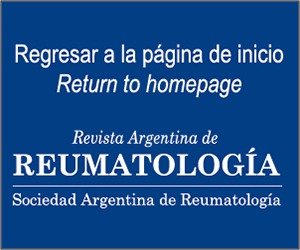Validación del Timed Up and Go Test como Predictor de Riesgo de Caídas en Sujetos con Artritis Reumatoidea
Parte II: Validez Concurrente y Predictiva
Resumen
Introducción: los sujetos con Artritis Reumatoidea (AR) tienen un elevado riesgo de caídas respecto a la población sana. El Timed Up and Go test (TUG) es utilizado para predecir el riesgo de caídas, pero no ha sido validado en sujetos con AR. Objetivos: el objetivo primario fue establecer la validez predictiva y la validez concurrente a velocidad habitual y máxima segura en sujetos con diagnóstico de AR. El objetivo secundario fue establecer si el TUG tiene mayor valor predictivo evaluado a velocidad habitual o a velocidad máxima segura.Citas
I. Stanmore EK, Oldham J, Skelton DA, O’Neill T, Pilling M, Campbell AJ, et al. Fall incidence and outcomes of falls in a prospective study of adults with rheumatoid arthritis. Arthritis care Res. 2013;65(5):737-44.
II. Armstrong C, Swarbrick CM, Pye SR, O’Neill TW. Occurrence and risk factors for falls in rheumatoid arthritis. Ann Rheum Dis. 2005;64(11):1602-4.
III. Ekdahl C, Andersson SI. Standing balance in rheumatoid arthritis. A comparative study with healthy subjects. Scand J Rheumatol. 1989;18(1):33-42.
IV. Hayashibara M, Hagino H, Katagiri H, Okano T, Okada J, Teshima R. Incidence and risk factors of falling in ambulatory patients with rheumatoid arthritis: a prospective 1-year study. Osteoporosis International. 2010;21(11):1825-33.
V. Zonzini Gaino J, Barros Bertolo M, Silva Nunes C, Morais Barbosa C, Sachetto Z, Davitt M, et al. Disease-related outcomes influence prevalence of falls in people with 4 rheumatoid arthritis. Ann Phys Rehabil Med. 2019;62(2):84-91.
VI. Lourenço M, Carli F, de Assis M. Characterization of falls in adults with established rheumatoid arthritis and associated factors. Adv Rheumatol. 2018;58(1).
VII. Podsiadlo D, Richardson S. The timed “Up & Go”: a test of basic functional mobility for frail elderly persons. J Am Geriatr Soc. 1991;39(2):142-8.
VIII. Módica M, Ostolaza M, Abudarham J, Barbalaco L, Dilascio S, Drault-Boedo ME, et al. Validación del Timed up and go test como predictor de riesgo de caídas en sujetos con artritis reumatoide. Parte I: confiabilidad y aplicabilidad clínica. Rehabilitación. 2017;51(4):226-33.
IX. Kang L, Han P, Wang J, Ma Y, Jia L, Fu L, et al. Timed Up and Go Test can predict recurrent falls: a longitudinal study of the community-dwelling elderly in China. Clin Interv Aging. 2017;12:2009-16.
X. Shumway-Cook A, Brauer S, Woollacott M. Predicting the probability for falls in community-dwelling older adults using the Timed Up & Go Test. Phys Ther. 2000;80(9):896-903.
XI. . Arnold CM, Faulkner RA. The history of falls and the association of the timed up and go test to falls and near-falls in older adults with hip osteoarthritis. BMC Geriatr. 2007;7:17.
XII. Bossuyt PM, Reitsma JB, Bruns DE, Gatsonis CA, Glasziou PP, Irwig L, et al. STARD 2015: an updated list of essential items for reporting diagnostic accuracy studies. Clin Chem. 2015;351:5527.
XIII. Maldonado Cocco JA, Citera G. Reumatología. 1er ed. Buenos Aires: Havas Medimedia; 2000.
XIV. Kristensen MT, Foss NB, Kehlet H. Timed “up & go” test as a predictor of falls within 6 months after hip fracture surgery. Phys Ther. 2007;87(1):24-30.
XV. Sociedad Argentina de Reumatología. [Internet] Información para Pacientes. Normativa para Certificación de Discapacidad en Pacientes con Artritis Reumatoidea (AR). Disponible en:
https://www.reumatologia.org.ar/recursos/normativa_para_certificacion_de_discapacidaden_en_pacientes_con_artritis_reumatoidea_ar.pdf [consultada el 26 de Diciembre de 2019].
XVI. Waimann CA, Citera G, Dal Pra FM, Marengo MF, Schneeberger EE, Sanchez M, et al. Validación de una versión argentina del Health Assessment Questionnaire-II (HAQ-II). Rev Argent Reumatol. 2011;22(2):21-9.
XVII. Sociedad Argentina de Reumatología. [Internet]Grupo de estudio de artritis reumatoidea. Actualización de las guías de práctica clínica en el tratamiento de la artritis reumatoidea 2013. Disponible en:
https://www.reumatologia.org.ar/recursos/guia_artritis_reumatoidea_2013.pdf
XVIII. Organización mundial de la salud. [Internet]. Caídas. Datos y cifras. Disponible en: http://www.who.int/mediacentre/facts-heets/fs344/es/ [consultada el 26 de Diciembre de 2019].
XIX. Vereeck L, Wuyts F, Truijen S, Van de Heyning P. Clinical assessment of balance: normative data, and gender and age effects. Int J Audiol. 2008;47(2):67-75.
XX. Salbach NM, Mayo NE, Higgins J, Ahmed S, Finch LE, Richards CL. Responsiveness and predictability of gait speed and other disability measures in acute stroke. Arch Phys Med Rehabil. 2001;82(9):1204-12.
XXI. Tyson S, Connell L. The psychometric properties and clinical utility of measures of walking and mobility in neurological conditions: a systematic review. Clin Rehabil. 2009;23: 1018–33.
XXII. Berg K, Wood-Dauphinee S, Williams JI. The Balance Scale: reliability assessment with elderly residents and patients with an acute stroke. Scand J Rehabil Med. 1995;27(1):27-36.
XXIII. Suzuki K, Imada G, Iwaya T, Handa T, Kurogo H. Determinants and predictors of the maximum walking speed during computer-assisted gait training in hemiparetic stroke patients. Arch Phys Med Rehabil. 1999;80(2):179-82.
XXIV. Hobart JC, Cano SJ, Warner TT, Thompson AJ. What sample sizes for reliability and validity studies in neurology? J Neurol. 2012;259:2681-94.
XXV. Juniper EF, Guyatt GH, Jaeschke R. How to develop and validate a new health-related quality of life instrument. In: Spilker, B., Ed., Quality of Life and Pharmacoeconomics in Clinical Trials, 2nd Edition, Lippincott-Raven Publishers, Philadelphia, 1996;49-56.
XXVI. Xie F, Thumboo J, Lo NN, Yeo SJ, Yang KY, Yeo W, et al. Cross-cultural adaptation and validation of Singapore English and Chinese versions of the Lequesne Algofunctional Index of knee in Asians with knee osteoarthritis in Singapore. Osteoarthr Cartil. 2007;15:19-26.
XXVII. De Boer MR, Moll AC, De Vet HC, Terwee CB, Volker-Dieben HJ, Van Rens GH. Psychometric properties of vision-related quality of life questionnaires: a systematic review. Ophthalmic Physiol Opt. 2004;24:257–73.
XXVIII. Hernández Sampieri R, Fernández Collado C, Baptista Lucio P. Metodología de la investigación. México. 2013;148-49:159-62.
XXIX. Knorr S, Brouwer B, Garland SJ.Validity of the Community Balance and Mobility Scale in community-dwelling persons after stroke.Arch Phys Med Rehabil. 2010;91(6):890-6.
XXX. Thrane G, Joakimsen RM, Thornquist E. The association between timed up and go test and history of falls: The Tromsø study. BMC Geriatr. 2007;7:1.
Derechos de autor 2019 Sociedad Argentina de Reumatología

Esta obra está bajo licencia internacional Creative Commons Reconocimiento-NoComercial-SinObrasDerivadas 4.0.






